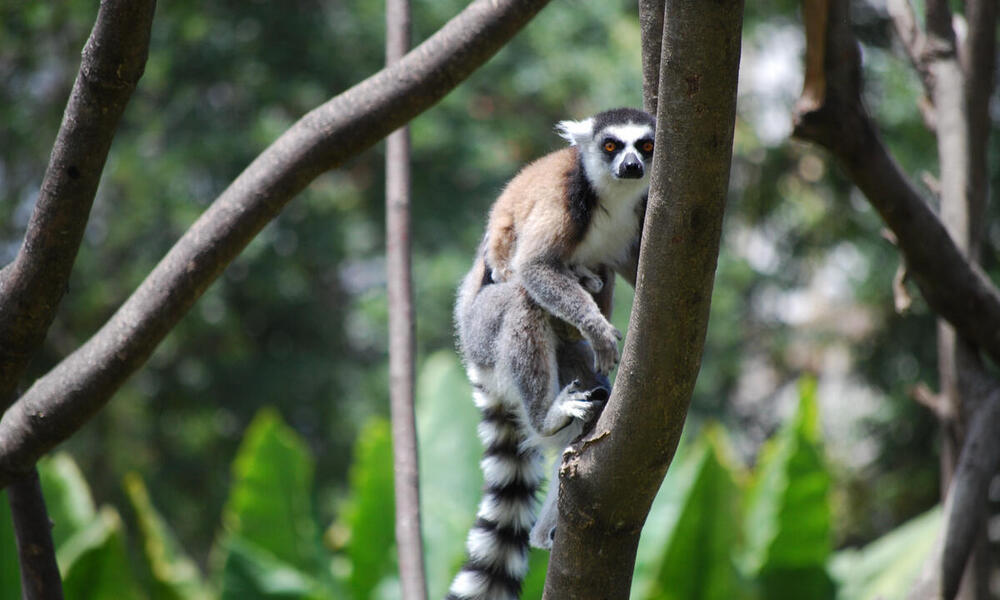The WWF is run at a local level by the following offices...
- WWF Global
- Adria
- Argentina
- Armenia
- AsiaPacific
- Australia
- Austria
- Azerbaijan
- Belgium
- Bhutan
- Bolivia
- Borneo
- Brazil
- Bulgaria
- Cambodia
- Cameroon
- Canada
- Caucasus
- Central African Republic
- Central America
- Central Asia
- Chile
- China
- Colombia
- Croatia
- Democratic Republic of the Congo
- Denmark
- Ecuador
- European Policy Office
- Finland
Our News
How WWF is protecting lemurs in Madagascar
The ring-tailed lemur and Verreaux’s sifaka, also known as the “dancing lemur,” are two of the 107 lemur species that live in Madagascar.
Protecting spiny forests and the wildlife that live there
Amoron’i Onilahy is a key refuge system for lemurs and serves as an important wildlife corridor between the southern and northern spiny forests. These unique forests are found nowhere else in the world and provide an important habitat for ring-tailed lemurs and Verreaux’s sifakas. Many of the plants in this arid environment have impressive water-conserving qualities due to their spines, hence the name “spiny forest.” These spines developed as an adaptation to droughts in the area and help the plants to reduce water loss and avoid being eaten.
WWF works closely with communities to protect these species and habitat in Amoron’i Onilahy —one of the last strongholds for ring-tailed lemurs and Verreaux’s sifakas. Local community patrollers, known as polisin’ala, help monitor and protect lemurs and their forests in six sites across the protected area. The polisin’ala also work alongside local communities and ecologists, as well as students from several universities to monitor lemur population trends, behavior, and habitat quality, and to build scientific capacity to protect wildlife. As a result of these monitoring measures, there has been a 60% decrease in the deforestation rate in 2020 compared to 2019 in the Amoron'i Onilahy and an increase in lemur density from 2019 to 2022. The increased lemur density results from adult lemurs moving into Amoron'i Onilahy because it offers a protected space and enough resources to support additional lemurs.
Overall, WWF has trained close to 200 patrollers on patrol reporting, awareness, and communication strategies, with 30 trained in 2023. Now, smartphone technology is creating huge advances in our conservation efforts and allows the polisin’ala to use their phones to document and track lemur populations. A standardized community-based monitoring system using the Spatial Monitoring and Reporting Tool (SMART) has strengthened the capacity for better long-term monitoring of lemur populations.
Supporting communities
Community education
Local communities play a critical role in conservation. WWF works hand-in-hand with the communities around Amoron’i Onilahy to support coexistence alongside lemurs. WWF has connected with 38 primary and secondary schools—eight in 2023—as part of awareness and education programs to help students learn about these lemurs. We provided educational booklets on lemur conservation and hosted local film screenings. WWF also ran an awareness campaign on World Lemur Day 2022 at both the local and national levels about the laws and regulations that prohibit owning, capturing, or selling lemurs for the pet trade or for personal pets. Spreading awareness about the importance of lemurs to biodiversity is a great step towards coexistence and species protection
Community livelihoods
The confluence of COVID-19 and its impact on Madagascar’s vibrant tourism industry and a devastating drought, has endangered livelihoods across the country. WWF and partners are working directly with local communities on sustainable livelihood initiatives that are not tourism-dependent. One of these initiatives focuses on improved production methods for siratany, a culinary salt extracted from the soil in southwestern Madagascar. WWF is providing new cookstoves and cooking pans that reduce the amount of wood required to produce this precious salt, which helps reduce deforestation. WWF is also working with a local private partner, Antsokay Arboretum, to help build the infrastructure related to siratany processing, packaging, and advertising. The Arboretum is directly connected to the local producers, allowing local producers to see better profits. It also ensures market access to a bigger town, along with the collection, transportation, packaging, advertising, and sale of the product. More recently, WWF has been working with local craftspeople to create new pots to help extract the salt. These improved pots can extract enough salt to support 15 community members, allowing more people to participate while supporting local craftspeople.
 © WWF / Martina Lippuner
© WWF / Martina Lippuner